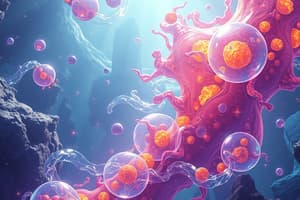Podcast
Questions and Answers
Which of the following best describes osmolarity?
Which of the following best describes osmolarity?
- The solute concentration of a solution (correct)
- The movement of water across a selectively permeable membrane
- The net flow of water from hypoosmotic to hyperosmotic solution
- The equal movement of water in both directions
If two solutions are isoosmotic, what can be said about the movement of water?
If two solutions are isoosmotic, what can be said about the movement of water?
- The movement of water is equal in both directions (correct)
- The movement of water is from hypoosmotic to hyperosmotic solution
- The movement of water is from hyperosmotic to hypoosmotic solution
- The movement of water is determined by the solute concentration
What is the direction of net flow of water if two solutions differ in osmolarity?
What is the direction of net flow of water if two solutions differ in osmolarity?
- From hyperosmotic to hypoosmotic solution
- From isoosmotic to hypoosmotic solution
- From hypoosmotic to isoosmotic solution
- From hypoosmotic to hyperosmotic solution (correct)
Which term describes a solution with a lower solute concentration?
Which term describes a solution with a lower solute concentration?
What is the term for a solution with a higher solute concentration?
What is the term for a solution with a higher solute concentration?
What determines the movement of water across a selectively permeable membrane?
What determines the movement of water across a selectively permeable membrane?
If two solutions have the same osmolarity, what can be said about their movement of water?
If two solutions have the same osmolarity, what can be said about their movement of water?
What is the term for the solute concentration of a solution?
What is the term for the solute concentration of a solution?
Which of the following is true when two solutions differ in osmolarity?
Which of the following is true when two solutions differ in osmolarity?
What can be said about the movement of water in isoosmotic solutions?
What can be said about the movement of water in isoosmotic solutions?
Which of the following statements about osmoconformers is true?
Which of the following statements about osmoconformers is true?
Which of the following statements about osmoregulators is true?
Which of the following statements about osmoregulators is true?
How do marine fish balance water loss and excrete salt?
How do marine fish balance water loss and excrete salt?
How do freshwater fish replenish salts?
How do freshwater fish replenish salts?
What mechanisms do land animals have to prevent dehydration?
What mechanisms do land animals have to prevent dehydration?
What are the most significant nitrogenous wastes?
What are the most significant nitrogenous wastes?
What do most terrestrial animals and many marine species excrete as a conversion product of ammonia?
What do most terrestrial animals and many marine species excrete as a conversion product of ammonia?
What do insects, land snails, and many reptiles including birds excrete as a semisolid paste?
What do insects, land snails, and many reptiles including birds excrete as a semisolid paste?
What are the forms of nitrogenous waste?
What are the forms of nitrogenous waste?
What are the nitrogenous breakdown products of proteins and nucleic acids?
What are the nitrogenous breakdown products of proteins and nucleic acids?
Flashcards are hidden until you start studying
Study Notes
Osmolarity and Osmotic Movement
- Osmolarity refers to the solute concentration of a solution.
- If two solutions are isoosmotic, there is no net movement of water between them.
- When two solutions differ in osmolarity, water flows from the solution with lower osmolarity (hypotonic) to the solution with higher osmolarity (hypertonic).
- A solution with a lower solute concentration is called hypotonic.
- A solution with a higher solute concentration is called hypertonic.
- The movement of water across a selectively permeable membrane is determined by the osmolarity of the solutions on either side.
Osmoregulation and Osmoconformity
- Osmoconformers are organisms that conform to the osmolarity of their surroundings.
- Osmoregulators are organisms that maintain a constant osmolarity despite changes in their surroundings.
- Marine fish balance water loss and excrete salt through specialized kidneys and salt-excreting glands.
- Freshwater fish replenish salts by absorbing ions from the water through their gills.
Excretion and Nitrogenous Wastes
- Land animals have mechanisms to prevent dehydration, including efficient kidneys, producing concentrated urine, and conserving water through behavior and physiology.
- The most significant nitrogenous wastes are ammonia, urea, and uric acid.
- Most terrestrial animals and many marine species excrete urea as a conversion product of ammonia.
- Insects, land snails, and many reptiles, including birds, excrete uric acid as a semisolid paste.
- The nitrogenous breakdown products of proteins and nucleic acids are ammonia, urea, and uric acid.
Studying That Suits You
Use AI to generate personalized quizzes and flashcards to suit your learning preferences.




